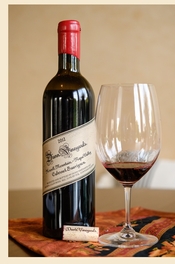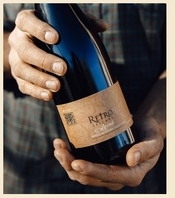Growing up, Mike never envisioned himself taking over the family business. As he recalls, working in the winery was his “chore while growing up”—the thing he had to do. It didn’t help that he and Randy are both a bit hard-headed, and often found reasons to lock horns over this or that. Instead, Mike was content to surf and work on bikes, eventually opening up a successful bike repair shop in Calistoga. And while Mike would come by the winery from time to time, if he and Randy could agree on anything it was this: Mike had it good being his own boss, and he wouldn’t like working for Randy.
Life didn’t let Mike stay away for long. though. In 1999, Mike’s sister, Jennifer, contracted bacterial meningitis and passed away unexpectedly. That event shook the Dunn family, and as Mike tells it, the loss and sadness that followed can still be discerned in the wines of that era. Mike could see that the loss had taken a toll on his mom and Randy, and it was then that he returned home and started working in the winery.
Mike isn’t a trained winemaker—and he’ll be the first to tell you that he knew very little about winemaking when he first came back to the winery—but luckily, Mike is good at figuring things out on the job. And he had to be. Randy is far from a hands-on teacher, and Mike was often left to his own devices to figure things out. He did just that, leaving his mark on the wines as he did.
One of Mike’s early accomplishments in the winery was wresting control of 2002 vintage from the grip of brettanomyces. Starting in the late 90’s, as temperatures crept upwards ever so slightly, brettanomyces, a spoilage yeast (one that can add character to a wine in small quantities but which can lead to off flavors and aromas when uncontrolled) suddenly became a more potent problem for Dunn. Where it once contributed subtle savory and earthy notes to Dunn’s Cabernets, it was now imparting much more potent and less favorable notes. Mike was instrumental in developing a new cleaning and filtering regimen in the winery that allowed Dunn to rein in the yeast’s proliferation.
As time has gone on, Mike has made his mark in other ways too. He took the wines from 50% new French oak to 100% new French oak. In doing so, he changed cooperages, opting for a finer grain and lower toast level on the oak. The finer grain and lower toast provide a much more restrained profile and less over-the-top vanilla character. He also introduced a line of single-vineyard wines. These wines have been widely acclaimed, earning multiple 100-point scores.
One of the most controversial changes Mike may have brought about was  the move away from hand-dipped wax toppers for Dunn’s Howell Mountain Cabernet, opting for more traditional metal capsules instead. Dunn’s red wax seals are instantly recognizable, beautifully elegant, and infamously difficult to remove. The distinctive look of their red wax, which had a lighter, more matte finish than many other wax dipped wine bottles, came from using a harder, more brittle wax that tends to chip and shatter when opened incorrectly, often creating a mess. Indeed, ask any sommelier and they will have a story about someone they know feeling foolish when trying to open a bottle of Dunn table-side (Dunn even released a video, showing the multiple correct ways to remove their wax by (spoiler alert) melting the wax a bit first to minimize mess.
the move away from hand-dipped wax toppers for Dunn’s Howell Mountain Cabernet, opting for more traditional metal capsules instead. Dunn’s red wax seals are instantly recognizable, beautifully elegant, and infamously difficult to remove. The distinctive look of their red wax, which had a lighter, more matte finish than many other wax dipped wine bottles, came from using a harder, more brittle wax that tends to chip and shatter when opened incorrectly, often creating a mess. Indeed, ask any sommelier and they will have a story about someone they know feeling foolish when trying to open a bottle of Dunn table-side (Dunn even released a video, showing the multiple correct ways to remove their wax by (spoiler alert) melting the wax a bit first to minimize mess.
However, the ire of restaurant wine staff wasn’t the impetus for Mike to ditch the wax toppers; it was a risk issue. As Mike explained, Dunn’s fire insurance doesn’t cover bottled wine stored at their winery. And each year after bottling, it would take weeks to finish hand-dipping each bottle in wax. Thus, there were weeks of time during fire season in which nearly all of Dunn’s product was stored on-site, and hence uninsured. By switching to aluminum capsules, Dunn can top their entire vintage of bottles in a fraction of the time and get their product to their storage facility where it is both safer and insured. Despite the praise Mike’s decision has won him from service staff around the world (yes, he has literally received calls thanking him for removing the wax) he still insists on waxing Dunn’s more limited, single vineyard releases (and why not—they’re wines that special deserve a little extra flair!).
Mike isn’t responsible for all of the changes that the winery has seen since he came on board, as it is climate change that has forced his hand in some instances. Dunn’s wines were long known to be super structured and super tannic — all but unapproachable in their youth but remarkably rewarding for those with decades of patience. As a sommelier once said to me after I asked how long I should decant a bottle of Dunn’s Howell Mountain, “Dunn is never done.” That saying doesn’t hold quite as true these days. A slightly warmer climate has meant that Dunn’s wines are getting somewhat riper and slightly less tannic. This hasn’t prevented Dunn from ensuring that the wines have bright acidity, moderate alcohol levels, and good structure — but they are undeniably more approachable in their youth.
After several years learning the ropes at Dunn, Mike also started his own  wine brand, Retro Cellars. This is where Mike’s winemaking really came into its own. Like Dunn, Retro Cellars focuses on cooler-climate, mountain fruit, but instead of Cabernet, Retro utilizes Zinfandel, Syrah, and Petite Sirah. The wines take grapes that stereotypically make dense, brooding wines and turns them on their head. You’ll see what I mean by that if you read my tasting notes on two of the wines below.
wine brand, Retro Cellars. This is where Mike’s winemaking really came into its own. Like Dunn, Retro Cellars focuses on cooler-climate, mountain fruit, but instead of Cabernet, Retro utilizes Zinfandel, Syrah, and Petite Sirah. The wines take grapes that stereotypically make dense, brooding wines and turns them on their head. You’ll see what I mean by that if you read my tasting notes on two of the wines below.
Dunn Vineyards (Howell Mountain – Napa Valley) Cabernet Sauvignon 2019 ($175): Dunn’s 2019 Howell Mountain Cabernet Sauvignon is strikingly approachable when compared to releases from decades past. The bouquet shows aromas of bright cherries, blackberries, cassis, roses, currant leaves, and baking spices. As is typical for Dunn’s wines, the alcohol is moderate, sitting at 13.9%. The fruit notes drive the flavors, as fine-grained tannins and lifted acidity fade to a lingering, chocolate-like finish. 94
Dunn Vineyards (Howell Mountain – Napa Valley) Cabernet Sauvignon 2018 ($180): Dunn’s 2018 Howell Mountain Cabernet Sauvignon is darker and richer than the 2019. A medley of blue and black fruit aromas—blueberries, black plums, and black cherries—meet violets, mint leaves, and currant leaves. The wine’s texture is velvety in the mouth, complemented by chalky, structured tannins. Thirty-two months of aging in 100% new French oak lends a vein of baking spices and a touch of vanilla. Everything is kept fresh by zippy acidity. The wine is approachable and lush but will no doubt age with grace. 95
Dunn Vineyards (Napa Valley) Cabernet Sauvignon 2014 ($140): The 2014 Napa Cabernet Sauvignon from Dunn vineyards is drinking remarkably well right now. Plush, ripe red fruit notes recalling cherries, raspberries, and even strawberries all shine through. Aged in 100% new French oak, the wine benefits from a lovely combination of clove and cinnamon notes, sitting just behind the fruit. Lively and bright, the wine transitions from a fruit core to a milk chocolate-like finish. 93
Dunn Vineyards (Napa Valley) Cabernet Sauvignon 2012 ($135): The 2012 Napa Cabernet Sauvignon from Dunn vineyards has an old-school Dunn feel to it. Having had a decade to mature, the wine’s fine-grained tannins still provide fantastic structure. With fruit sourced from both Howell Mountain and Coombsville, the wine shows terrific balance of fruity and savory characteristics, with notes of currant leaves, mint leaves, blackberries and black cherries all coming through. There is fine grip and seductive bitter chocolate-like note in the lengthy finish. 93
Retro Cellars (Chiles Valley – Napa Valley) Zinfandel 2018 ($50): Retro Cellars’ 2018 Zinfandel from Chiles Valley is lifted, nimble, and floral. Zinfandel’s typical flavors and aromas of strawberry jam and black pepper are present, but they are packaged in a medium-bodied wine with bright acidity, showing beautiful scents of roses as well as violets. And while the alcohol hovers around 15% (it is still Zinfandel after all), you would never know it, as the alcohol is seamlessly integrated with the fruit and tannin. This may just be one of my all-time favorite Zinfandels. 95
Retro Cellars Los Abuelos (Howell Mountain – Napa Valley) Petite Syrah 2015 ($60): Retro Cellars’ 2015 Los Abuelos Petite Sirah is inky and structured, but has a certain grace and delicacy to it at the same time. Flavors recalling red plums, red cherries, and roses meet firm tannins and lifted acidity. While the wine sees aging in 100% new French oak, the Petite Sirah stands up to it well, allowing only subtle notes of baking spices and a touch of vanilla to show through. This is a beautiful example of how complex and interesting Petite Sirah can be. 94
